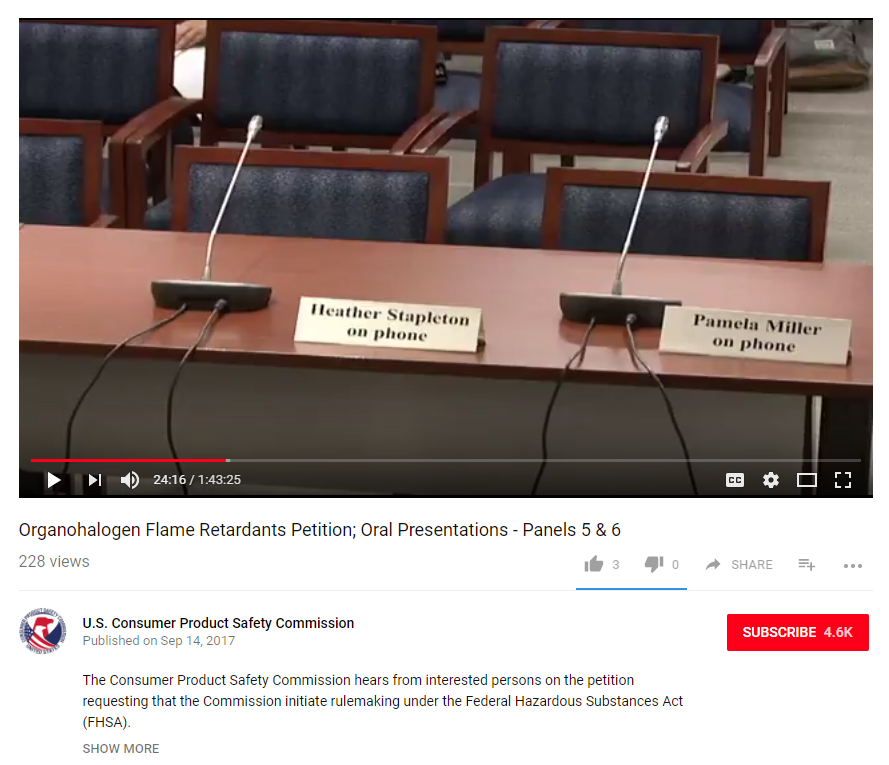Join us for this webinar organized by CHE and Boston University SRP
Oct 9, 2014
Eighth in a series of calls organized by CHE and the Boston University Superfund Research Program (BU SRP).
Flame retardants are chemicals that are used in consumer products ranging from furniture to electronics. On this call on Thursday October 9, 2014 at 10:00 am Pacific/1:00 pm Eastern, speakers will focus primarily on flame retardants used in polyurethane foam in furniture and related products, and briefly discuss the changing California regulations. They will review exposure and health effects of these flame retardants (PentaBDE) and the main replacements, (“chlorinated tris” and Firemaster 550). They will also discuss recent findings showing potential effects of components of Firemaster 550 on obesity and bone health.
Featured speakers
Tom Webster, DSc, is a professor of environmental health at Boston University’s School of Public Health. Dr. Webster has several main research areas: 1) exposure routes and health hazards of chemicals used in consumer products, especially polybrominated diphenyl ethers (PBDEs), other flame retardants, and perfluoralkyl compounds (PFCs); 2) mixtures of chemicals (with applications in toxicology and epidemiology); 3) endocrine disruption; 4) methodological aspects of environmental epidemiology, particularly issues in spatial epidemiology such as disease mapping and clusters, ecologic bias, and the use of combinations of individual and group level data. Like the rest of my department, I am very interested in the community context of environmental health. Dr. Webster served on the National Research Council’s Subcommittee on Fluoride in Drinking Water and the Institute of Medicine’s Committee on Making Best Use of the Agent Orange Exposure Reconstruction Model.
Jennifer Schlezinger, PhD, is an associate professor of environmental health at Boston University’s School of Public Health. Her PhD research involved the study of the molecular mechanisms of PCB toxicity in a marine fish model. Since coming to Boston University School of Public Health as a post-doctoral researcher in 1998, she has worked closely with Dr. David Sherr on immunotoxicology studies. Dr. Schlezinger is an active member of the Society of Toxicology. Her studies focus on the mechanisms by which environmental contaminants impair bone marrow physiology, both mesenchymal stem cell differentiation and B lymphocyte development. Currently, her laboratory is testing the hypotheses that 1) environmental obesogens (e.g. phthalates, organotins, organophophates) induce adipogenesis and suppress osteogenesis through activation of PPARg and RXR, accelerating the development of osteoporosis and 2) that environmental PPAR/RXR ligands suppress B lymphopoiesis by two mechanisms, directly by inducing apoptosis in early B cells and indirectly by altering the bone marrow microenvironment that supports lymphopoiesis, resulting in aging-like suppression of immune responses.
Heather Stapleton, PhD, is the Dan and Bunny Gabel Associate Professor of Environmental Ethics and Sustainable Environmental Management at Duke University. Dr. Stapleton’s research focuses on understanding the fate and transformation of organic contaminants in aquatic systems and in indoor environments. Her main focus has been on the bioaccumulation and biotransformation of brominated flame retardants, and specifically polybrominated diphenyl ethers,(PBDEs). Her current research projects explore the routes of human exposure to flame retardant chemicals and examine the way these compounds are photodegraded and metabolized using mass spectrometry to identify breakdown products/metabolites. She uses both in vivo techniques with fish, and in vitro techniques with cell cultures to examine metabolism of this varied class of chemicals. Also of interest to Dr. Stapleton is the study of the fate of PBDEs in the environment which may lead to bioaccumulation in aquatic systems and examining their bioavailability under different environmental conditions.
The call will last one hour and will be recorded for archival purposes.





